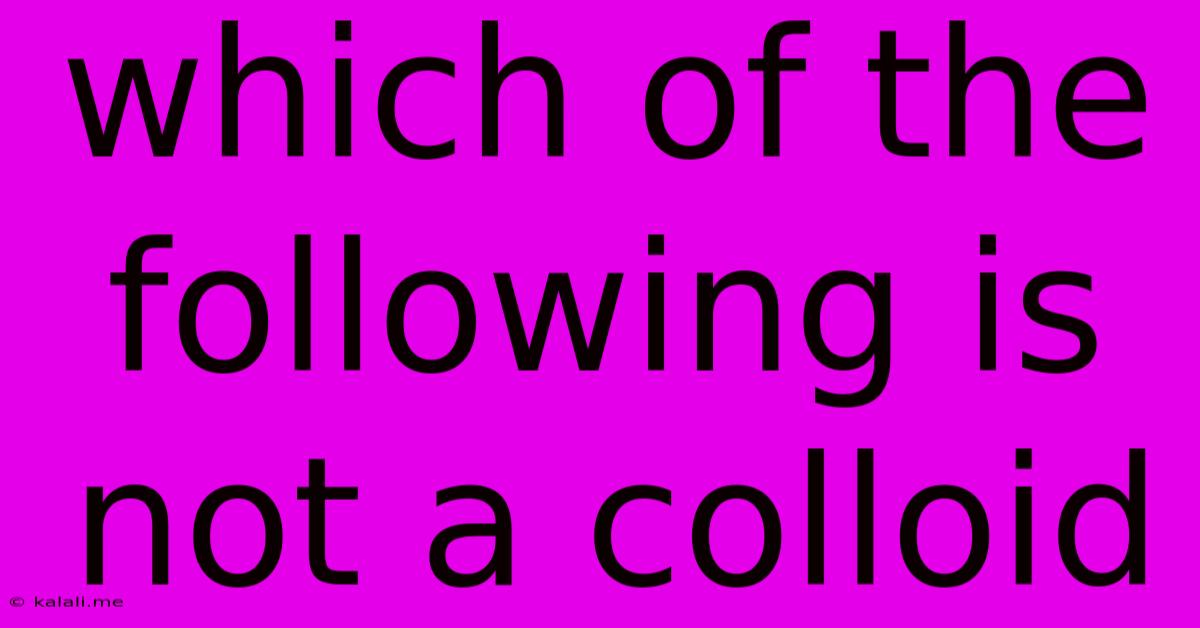Which Of The Following Is Not A Colloid
Kalali
Jun 13, 2025 · 3 min read

Table of Contents
Which of the following is NOT a Colloid? Understanding Colloid Properties
Colloids are a fascinating area of chemistry, representing a state of matter between a true solution and a suspension. Understanding what makes a colloid a colloid, and conversely, what doesn't qualify, is key to grasping their unique properties and applications. This article will explore the defining characteristics of colloids and examine examples of substances that are not colloids. By the end, you'll be able to confidently identify colloids and differentiate them from other mixtures.
What is a Colloid?
A colloid is a heterogeneous mixture where one substance is dispersed evenly throughout another. The dispersed particles are larger than those in a solution (e.g., salt dissolved in water) but smaller than those in a suspension (e.g., sand in water). This size range, typically between 1 and 1000 nanometers, is crucial. These particles, called colloids or dispersed phase, don't settle out over time and don't readily separate out by filtration. The substance the colloid is dispersed in is called the dispersion medium.
Key characteristics of colloids include:
- Particle size: 1-1000 nanometers
- Heterogeneous mixture: Particles are not uniformly distributed at a molecular level.
- Tyndall effect: Scattering of light by the colloidal particles, making a beam of light visible when passed through the colloid.
- No settling: Particles remain suspended indefinitely.
- Examples: Milk, fog, paint, blood, ink.
Substances that are NOT Colloids:
Several types of mixtures are often confused with colloids, but their differing particle sizes and properties set them apart. Here are some examples of what is not a colloid:
-
Solutions: These are homogeneous mixtures where solute particles (like salt or sugar) are completely dissolved in a solvent (like water). The particle size is significantly smaller than in colloids, typically at the molecular or ionic level. They don't exhibit the Tyndall effect. Examples include saltwater, sugar water, and air (a solution of gases).
-
Suspensions: Unlike colloids, suspensions have larger particles (greater than 1000 nanometers) that are visibly dispersed throughout the medium. These particles will eventually settle out due to gravity. Examples include muddy water, sand in water, and flour in water.
-
Pure Substances: These are made up of only one type of atom or molecule and don't involve mixtures or dispersions. Examples include pure water, pure gold, and pure oxygen.
Distinguishing Features: A Table for Clarity
To further clarify the differences, consider the following table:
| Feature | Solution | Colloid | Suspension |
|---|---|---|---|
| Particle Size | < 1 nm | 1-1000 nm | > 1000 nm |
| Homogeneity | Homogeneous | Heterogeneous | Heterogeneous |
| Settling | No | No | Yes |
| Tyndall Effect | No | Yes | Sometimes (depending on particle size) |
| Filtration | Passes through | Passes through | Does not pass through |
Conclusion:
Understanding the distinction between colloids and other mixtures is crucial in various scientific disciplines. By considering particle size, homogeneity, settling behavior, and the Tyndall effect, one can confidently identify whether a given substance is a colloid or not. The examples and table provided offer a clear guide to mastering this concept. Remember, the key differentiator lies in that sweet spot of particle size – neither too small to be a solution nor too large to be a suspension. This subtle but significant difference is what defines the unique world of colloids.
Latest Posts
Latest Posts
-
Common Factors For 84 And 105
Jun 14, 2025
-
Which Color Is Not A Primary Color
Jun 14, 2025
-
What Is The Difference Between A Square And Rhombus
Jun 14, 2025
-
The Normal Rbc Graveyard Is The Liver
Jun 14, 2025
-
Can You Reschedule A Sat Test
Jun 14, 2025
Related Post
Thank you for visiting our website which covers about Which Of The Following Is Not A Colloid . We hope the information provided has been useful to you. Feel free to contact us if you have any questions or need further assistance. See you next time and don't miss to bookmark.